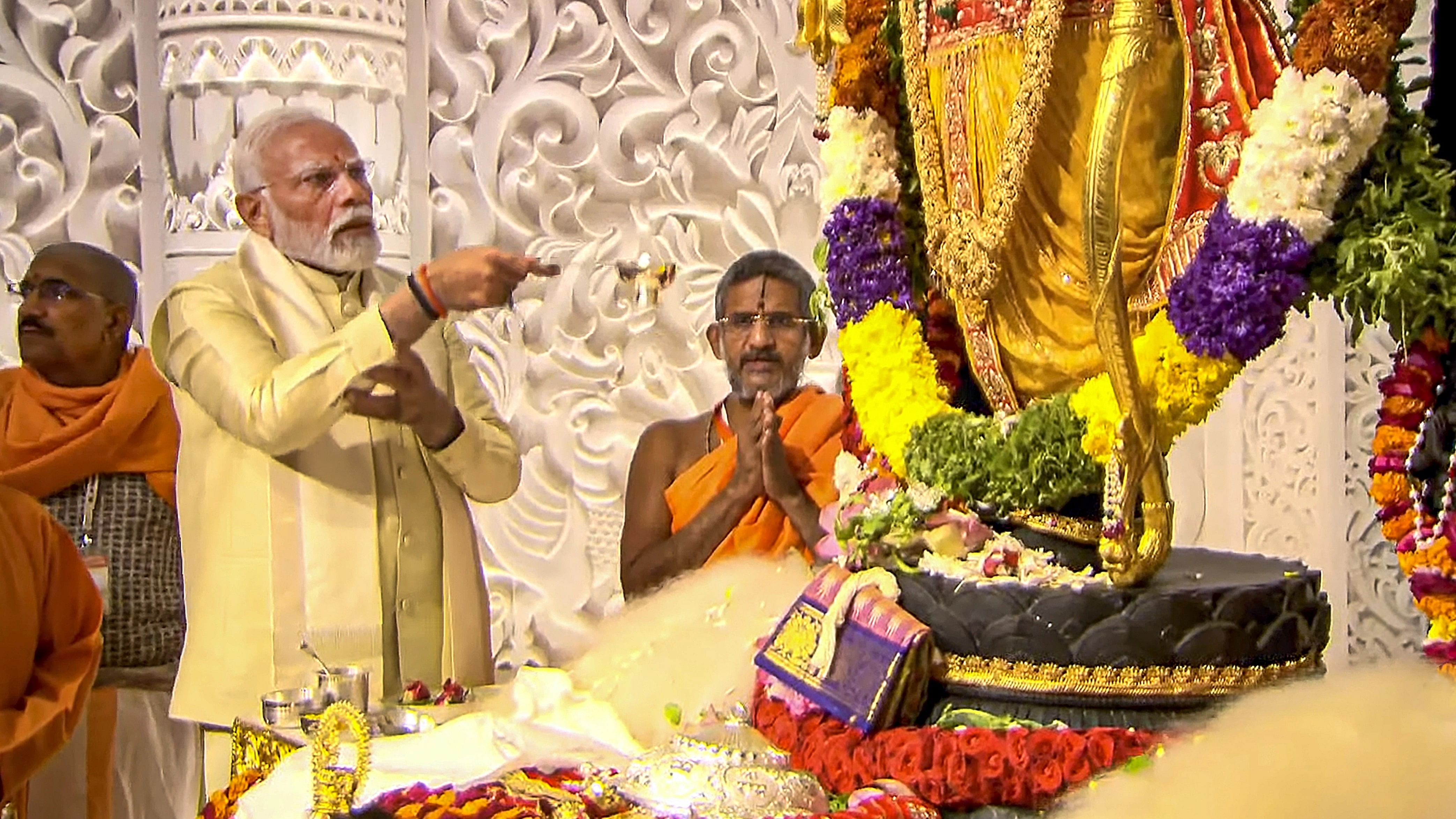
Prime Minister Narendra Modi offers prayers before the idol of Ram Lalla during the 'Pran Pratishtha' rituals at the Ram Mandir.
Credit: PTI
Ayodhya: The new Ram Lalla idol was consecrated at the Ayodhya temple on Monday, an event led by Prime Minister Narendra Modi and watched by lakhs of people on television at their homes and in temples across the country.
Army helicopters showered flower petals on the newly constructed Janmabhoomi temple as the ‘pran pratishtha’ ceremony took place – a seminal occasion in India's political and religious history.
"The extraordinary moment of the consecration of Shri Ram Lalla's life in Ayodhya Dham is going to leave everyone emotional. It is my great pleasure to be a part of this divine programme. Hail Siya Ram!" Modi tweeted.
At the end of ceremony, Modi prostrated himself before the idol.
Modi took part in the 'pran pratishtha' rituals in the presence of Uttar Pradesh Governor Anandiben Patel, Chief Minister Yogi Adityanath and RSS chief Mohan Bhagwat.
From the sanctum sanctorum, Modi next headed for another location to address a gathering of about 8,000, which included seers, people linked to Ram Janmabhoomi movement and celebrities from fields like entertainment, sports and industry.
He was also slated to visit the Kuber Tila, and interact with workers associated with the construction of temple.
Senior BJP leaders including party chief J P Nadda and Union Home Minister Amit Shah watched the live streaming of the ceremony.
Top Opposition leaders skipped the ceremony. But Himachal Pradesh minister Vikramaditya Singh, who is the son of state Congress chief Pratibha Singh, arrived at the venue.
Several BJP-run states had declared the day a holiday to allow people to watch the ceremony on tv and also take part in events at neighbourhood temple.
Fifty traditional musical instruments from across the country were part of a devotional "Mangal Dhwani" that resonated during the consecration ceremony.
Orchestrated by Ayodhya's celebrated poet Yatindra Mishra, the grand musical rendition was supported by New Delhi’s Sangeet Natak Akademi, New Delhi.
The instruments included pakhawaj, flute and dholak from Uttar Pradesh, veena from Karnataka, algoja from Punjab, sundari from Maharashtra, mardala from Odisha, santoor from Madhya Pradesh, pung from Manipur, nagada and kali from Assam and tambura from Chhattisgarh.
The run-up to the consecration ceremony, which takes place just months before the Lok Sabha elections, was marked by sparring between the ruling BJP and the Opposition.
Also Read | Ayodhya Ram Mandir Timeline: Faith, Fervour, Furore
The Opposition called it an RSS-BJP event.
The run-up to the temple’s inauguration – only the first phase of the construction is over at this stage – also saw much religious fervor.
Devotees arrived from several parts of the country to the temple town to be part of the occasion, while being aware that they could not attend the main ceremony.
Ceremonial gates depicting 'Jai Shri Ram' in floral patterns and illumination visible at night added to the aura of the ancient city which has undergone a massive infrastructural growth in the last couple of years, after the 2019 Supreme Court verdict on the temple-mosque dispute.
The 16th century Babri mosque, which many Hindus believe was constructed on the site of Lord Ram’s birthplace, was demolished by kar sevaks on December 6, 1992.
After a protracted legal battle, the Supreme Court in November 2019 ruled in favour of the construction of the temple. It also ordered allotment of a five-acre plot for the construction of a mosque.